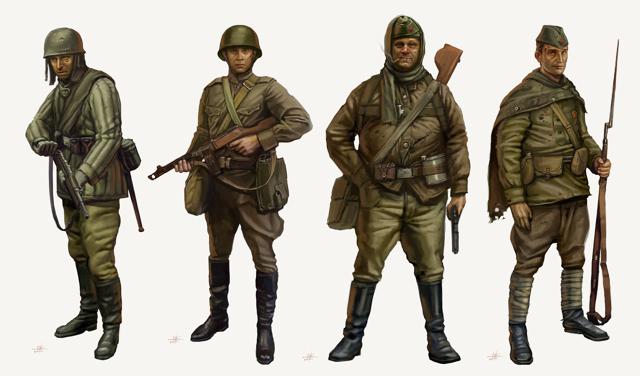10 Stalinist strikes, or the campaign of 1944 - this is what they call the series of successful offensive operations of the Soviet army after a radical change in 1943. What were these blows? Why is their value so high? What role did the Kiev offensive operation play during this period? We will try to answer these and other questions below.
Was an alternative outcome of the events of 1944 possible?
In 1944, it was clear that this was the time of decisive battles and that the winner would be determined right now. It was also obvious that the USSR, after a radical change (the beginning of which was the Kiev offensive operation), was confidently advancing and causing German troops considerable trouble on the Eastern Front.

Theoretically, Hitler could ask for peace not from the Western countries, but from the Soviet Union. The West did not need Germany, broken by the war, but the Soviet Union could have had a serious profit from Hitler's surrender. Of course, in this scenario, the Fuhrer would not have survived, so he chose the tactics of prolonging the war, expecting that political factors would decide everything. One of such factors could be, for example, a split among the opposing countries. The problem was that Hitler could not provoke this split, because of which the tactics of prolonging the war today seems rather unreasonable. Another factor that would justify a protracted company could be the development of a "superweapon." 10 Stalinist strikes clearly showed that it would be more reasonable to sign surrender and not bring the situation at the front to such a deplorable state. But consider in more detail.
10 Stalinist strikes - 10 tactical and strategic victories of the Soviet Union
Start. The first blow (January 1944) - the displacement of the Germans in the Baltic countries.
The German defense near Leningrad at that time was already broken, and the enemy was forced to conduct military operations in the conditions of an extended flank, interrupted communications and an unreliable ally in the person of Finland.
After that, peace negotiations began with the active assistance of Roosevelt, who threatened to break off diplomatic relations with Finland. A little later, the Union removed all conditions for preliminary negotiations, thereby depriving the Finnish government of the opportunity to balance between the "two chairs". Against the background of Hitler, who even in the role of an ally directly threatened the Finns with occupation, the USSR looked much more preferable. Next, we will consider all 10 Stalinist strikes. The table is presented below:
| lifting of the siege of Leningrad | January 1944 |
| Korsun-Shevchenkovsky | February 1944 |
| Crimea, Odessa | April 1944 |
| Karelia | June 1944 |
| Belarus | June-August 1944 |
| crossing the Vistula | August 1944 |
| Moldova | August 1944 |
| The Baltic states | September 1944 |
| Hungary | October-December 1944 |
| Norway and the Arctic | October 1944 |
Korsun-Shevchenko offensive operation
Its peculiarity is that the first thing that was cut was the Odessa-Vilnius railway, which served as the main communication between the units of the German army. Germany followed a stiff defense strategy. In practice, this meant that the Soviet army attacked where it was convenient, due to the considerable length of the front line and the numerical superiority.
Liberation of Crimea
Despite the prevailing opinion that Stalin thoughtlessly sent soldiers to death, as a result of the Crimean operation, the losses of the enemy far exceeded the losses of the Union. The whole thing in the order given by Stalin is not to "waste" human resources.
As a result, the Germans were literally crushed by artillery fire and massive shelling from the air.
Karelia: fourth hit
During the liberation of Karelia and Petrozavodsk, the Finns were driven back inland. The Union Army stopped in June. Weapons were enough to defeat the enemy, and the negotiation process was in full swing, but the forces were needed in other positions.
Operation Bagration
Western historians call it simply the destruction of the Army Center. At the same time, the Belarusian Soviet Socialist Republic was liberated as a result of the operation , and access was also made to the Vistula, where part of the allied Poland at that time was liberated. An exit to the Neman was also carried out with the subsequent release of part of the Lithuanian Soviet Republic. It is also important that during the same operation the Neman was forced to force, as a result of which the Soviet army actually approached the borders of Germany.
Operation in Ukraine
This blow solved not only local, but also global tasks by means of pressure on the center, without which it is impossible to make a breakthrough on the flanks. In addition, it was necessary to solve the problem with the German mobile units, since the enemy was already starting the withdrawal of troops.
As a result, the German army was defeated near Lviv, and Soviet troops were given the opportunity not only to liberate Western Ukraine, but also to force the Vistula.
Iasi-Chisinau operation
In the same year, 1944, the Iasi-Chisinau operation was carried out, as a result of which the liberation of Moldova took place. In addition, it was possible to withdraw from the war Romania, which was an ally of Hitler. The country's leadership immediately declared war on both Germany and Hungary.
The eighth blow was the liberation of the Baltic states, and the ninth - Hungary. Tenth hit - Norway. Soviet troops deprived Germany of ice-free ports and raw materials. In addition, the USSR army entered the state border along its entire perimeter. Thus began the liberation of the countries captured by Germany.
So we examined 10 Stalinist attacks briefly, clearly and on the case.